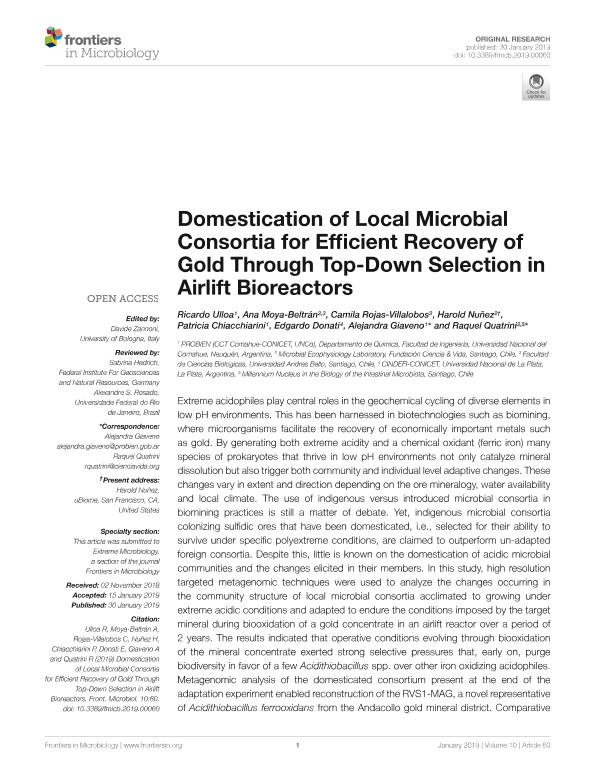Artículo
Domestication of local microbial consortia for efficient recovery of gold through top-down selection in airlift bioreactors
Ulloa, Ricardo; Moya Beltrán, Ana; Rojas Villalobos, Camila; Nuñez, Harold; Chiacchiarini, Patricia Alejandra; Donati, Edgardo Ruben ; Giaveno, Alejandra; Quatrini, Raquel
; Giaveno, Alejandra; Quatrini, Raquel
 ; Giaveno, Alejandra; Quatrini, Raquel
; Giaveno, Alejandra; Quatrini, Raquel
Fecha de publicación:
04/2019
Editorial:
Frontiers Media S.A.
Revista:
Frontiers in Microbiology
ISSN:
1664-302X
Idioma:
Inglés
Tipo de recurso:
Artículo publicado
Clasificación temática:
Resumen
Extreme acidophiles play central roles in the geochemical cycling of diverse elements in low pH environments. This has been harnessed in biotechnologies such as biomining, where microorganisms facilitate the recovery of economically important metals such as gold. By generating both extreme acidity and a chemical oxidant (ferric iron) many species of prokaryotes that thrive in low pH environments not only catalyze mineral dissolution but also trigger both community and individual level adaptive changes. These changes vary in extent and direction depending on the ore mineralogy, water availability and local climate. The use of indigenous versus introduced microbial consortia in biomining practices is still a matter of debate. Yet, indigenous microbial consortia colonizing sulfidic ores that have been domesticated, i.e., selected for their ability to survive under specific polyextreme conditions, are claimed to outperform un-adapted foreign consortia. Despite this, little is known on the domestication of acidic microbial communities and the changes elicited in their members. In this study, high resolution targeted metagenomic techniques were used to analyze the changes occurring in the community structure of local microbial consortia acclimated to growing under extreme acidic conditions and adapted to endure the conditions imposed by the target mineral during biooxidation of a gold concentrate in an airlift reactor over a period of 2 years. The results indicated that operative conditions evolving through biooxidation of the mineral concentrate exerted strong selective pressures that, early on, purge biodiversity in favor of a few Acidithiobacillus spp. over other iron oxidizing acidophiles. Metagenomic analysis of the domesticated consortium present at the end of the adaptation experiment enabled reconstruction of the RVS1-MAG, a novel representative of Acidithiobacillus ferrooxidans from the Andacollo gold mineral district. Comparative genomic analysis performed with this genome draft revealed a net enrichment of gene functions related to heavy metal transport and stress management that are likely to play a significant role in adaptation and survival to adverse conditions experienced by these acidophiles during growth in presence of gold concentrates.
Archivos asociados
Licencia
Identificadores
Colecciones
Articulos(CINDEFI)
Articulos de CENT.DE INV EN FERMENTACIONES INDUSTRIALES (I)
Articulos de CENT.DE INV EN FERMENTACIONES INDUSTRIALES (I)
Citación
Ulloa, Ricardo; Moya Beltrán, Ana; Rojas Villalobos, Camila; Nuñez, Harold; Chiacchiarini, Patricia Alejandra; et al.; Domestication of local microbial consortia for efficient recovery of gold through top-down selection in airlift bioreactors; Frontiers Media S.A.; Frontiers in Microbiology; 10; 60; 4-2019; 1-14
Compartir
Altmétricas



